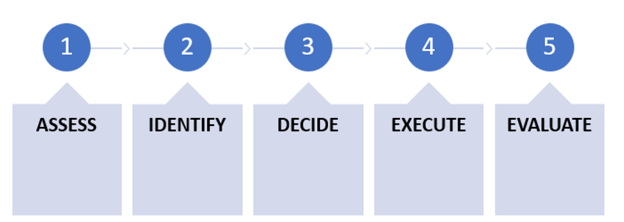Steps to Create a Professional Development Plan
Professional development is most effective when it is intentional, focused, and rooted in our long-term career goals and aspirations. There are many different professional development activities available to us, but our time is finite and precious. Creating a professional development plan (PDP) allows you to prioritize and organize your efforts to keep you moving closer to where you want to be.
There are many ways to go about creating an effective PDP. The steps below can help get you started, but don't be afraid to experiment to figure out what works for you and your institution.

1) ASSESS where you are now. What is your current job title, level, and (most importantly) what is your current set of professional skills and competencies?
- What have you been doing over the past year, three years, or five years to help your professional development?
- Are you where you thought you'd be at this stage in your career?
- A PDP is a great way to start or continue your career growth. If you have been actively engaged with professional development, but you're not where you thought you'd be, this is a great opportunity to assess the effectiveness of your past strategies and actions.
- Write down things that have helped or hindered your development in the past.
2) IDENTIFY your specific career goals and the skills, competencies, and experience you need to achieve them.
- Cast your mind into the future and determine where you'd like to be in your career. Instead of jumping right to a specific job title, first ask yourself things like:
- What does success mean to me?
- What activities do I love the most?
- What makes me feel most fulfilled in my professional life?
- Am I experiencing a version of this success in my current job?
- Where would I like to be in five years? 10 years?
- Use your answers to those questions to identify jobs that will fulfill your specific needs.
- Next, create a list of skills, experience, and competencies you need to achieve your long-term vision and goals. Compare this list to your existing competencies and skills. You should be able to see very clearly what is required to realize your vision of the future. What do you still need to gain or work on? These are the items that your professional development activities should provide you.
- This stage is a great time to talk to your direct supervisor, or someone in a position that you hope to grow into.
3) DECIDE on a strategy and timeline.
- First, take stock of the professional development opportunities available to you, and select the ones that align with your goals.
- Set both short- and long-term goals and write them down! Be sure to make them SMART goals (Specific, Measurable, Achievable, Realistic, Timely).
- Next, decide on a timeline. It's important to give yourself deadlines and targets to ensure continuous progress. Plan your targets on a yearly basis and consider using your annual performance goals to track one or more of these goals.
- Work with your leader for advice and support. They can help you ensure that your goals are a good balance of ambitious and realistic, as well help you identify additional opportunities for growth.
- The most important thing is to write it all down with specific expectations, due dates, etc.
4) EXECUTE your plan.
- This is a long-term effort, and if you're doing it right, it will be a continual process throughout your career.
- Whenever appropriate, block out time on a regular basis to engage with professional development. When we get busy, professional development can be one of the first and easiest things to drop off of our priority list. Blocking out and setting aside time in small, manageable chunks throughout the year can help you to maintain consistent progress toward your goals.
- Don't be afraid to jump on new opportunities as they arise. They may not be a part of your original plan, but as long as they still move you closer to your long-term goals, you can add them to your plan along the way.
- And finally, what we learn is only valuable if we remember it and know how to apply it. Be sure to look for ways to apply the things you're learning through professional development.
5) EVALUATE your progress.
- This often happens during annual performance reviews, but you should get into the habit of checking your progress against your timeline at a more regular cadence.
- Measuring your progress will help you know if you are hitting appropriate milestones, are meeting your targets, and are on track for reaching your goals. You may need to set more manageable steps, or make new targets, or even set new goals.
- If you have to adjust your plan or adjust your deadlines, this doesn't mean you've failed as long as you're still making forward progress. Plans change and, as you go through your career, your goals will progress with you.
- Consider identifying one or more people to help hold you accountable and celebrate your successes.
Return to Toolkit Home | Continue to Professional Development Resources >>



